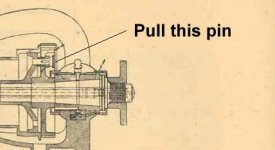TwistedTransisto
Plastic
- Joined
- Dec 17, 2018
Hello guys,
I've been lurking around for a while since. I've always been fascinated about making things. Electronics, eventually picked up a 3D printer (which turns out is not all that appropriate to make a lot of things), and finally decided to pull the trigger and get a lathe.
I was going to get a mini lathe, since 99% of the stuff I'd make would be simple and small, but then I found this little piglet on craigslist for $200.
It has markings that I could find, not plates on it of any sort, not even gear ratios, etc. The only id plate on the entire setup is on the motor (which from the sticky on this forum won't help with the id).
The previous owner picked it up used and all he could tell me about the lathe is that it was likely a South Bend, he had it for 20 years and he used to use it to turn pool cue sticks (he used to own a pool hall).
It came with a few cutting tools, 3 or 4 wrenches, a chuck and a round plate, threaded in the center but no markings or wholes in it at all.
I was hoping one of you guys could help me ID the lathe. I took pictures of it as described in the sticky post.
Thank you in advance, and cheers!
EDITED: It seems there is a maximum of 5 pics per thread so I added the links to all the pics instead. These are high resolution images, so it is possible to zoom in on to see the apron and top of carriage up close.
ID pics of the lathe
I've been lurking around for a while since. I've always been fascinated about making things. Electronics, eventually picked up a 3D printer (which turns out is not all that appropriate to make a lot of things), and finally decided to pull the trigger and get a lathe.
I was going to get a mini lathe, since 99% of the stuff I'd make would be simple and small, but then I found this little piglet on craigslist for $200.
It has markings that I could find, not plates on it of any sort, not even gear ratios, etc. The only id plate on the entire setup is on the motor (which from the sticky on this forum won't help with the id).
The previous owner picked it up used and all he could tell me about the lathe is that it was likely a South Bend, he had it for 20 years and he used to use it to turn pool cue sticks (he used to own a pool hall).
It came with a few cutting tools, 3 or 4 wrenches, a chuck and a round plate, threaded in the center but no markings or wholes in it at all.
I was hoping one of you guys could help me ID the lathe. I took pictures of it as described in the sticky post.
Thank you in advance, and cheers!
EDITED: It seems there is a maximum of 5 pics per thread so I added the links to all the pics instead. These are high resolution images, so it is possible to zoom in on to see the apron and top of carriage up close.
ID pics of the lathe
Last edited:



